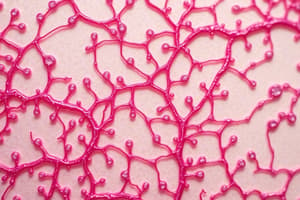Podcast
Questions and Answers
What are the main functions of connective tissue?
What are the main functions of connective tissue?
Providing support, binding organs, regulating temperature, transporting nutrients, and storing fats.
Describe the infrastructure of connective tissue.
Describe the infrastructure of connective tissue.
Collagen fibers and proteoglycans form the infrastructure of connective tissue.
What does histology study?
What does histology study?
Histology studies cell and tissue organization.
How do microscope images help in understanding tissues?
How do microscope images help in understanding tissues?
What are the four primary classes of tissues?
What are the four primary classes of tissues?
What are the distinguishing characteristics of epithelial tissue?
What are the distinguishing characteristics of epithelial tissue?
How does muscle tissue contribute to bodily functions?
How does muscle tissue contribute to bodily functions?
What is the main function of nervous tissue?
What is the main function of nervous tissue?
Give examples of different types of epithelial tissue.
Give examples of different types of epithelial tissue.
How do tissues contribute to maintaining homeostasis?
How do tissues contribute to maintaining homeostasis?
Flashcards are hidden until you start studying
Study Notes
Tissues: Foundation Blocks of Living Organisms
At the heart of our bodies' complex structures lie tissues, which are organized collections of specialized cells working together to perform specific tasks within living organisms. Understanding tissues is crucial when delving into biology because they lay the groundwork for organs and systems—the very building blocks of life. Let's explore different aspects of these essential entities.
Connective Tissue
Connective tissue serves many purposes, such as providing support, binding organs, regulating temperature, transporting nutrients, and storing fats. This versatile type includes loose connective tissue, dense irregular connective tissue, dense regular connective tissue, elastic fiber-rich connective tissue, cartilage, bone, and lymphatic tissue. Collagen fibers and proteoglycans form its infrastructure, helping to maintain the body's overall structure and stability.
Histology
Histology, the study of cell and tissue organization, provides valuable insights into the microscopic features of tissues. Microscope images reveal distinct patterns within various tissues. For instance, epithelial tissue, discussed next, often displays tightly connected overlapping cells with uniform appearance, while connective tissue exhibits loosely arranged collagen fibers.
Types of Tissues
There are four primary classes of tissues: epithelial, connective, muscle, and nervous. Each has distinguishing characteristics tailored towards their unique roles in the body. Epithelial tissue covers surfaces like skin and lines internal cavities; it can also function as glands and serve protective duties. Muscle tissue contracts, allowing us to move and respond to stimuli. Nervous tissue transmits signals via neurons, assisting communication between cells and coordinating bodily activities.
Epithelial Tissue
Epithelial tissues envelop internal organs and cover external surfaces, forming protective barriers and facilitating selective permeability. They provide protection against physical damage, invasions by pathogens, excessive water loss, and help regulate substances entering and exiting the body. Examples include squamous, cuboidal, columnar, ciliated, and transitional epithelium.
Functions of Tissues
Tissues facilitate various critical tasks relevant to survival and functioning of multicellular organisms. These include sensory perception through neural tissue, generating movement thanks to muscular tissue, transferring oxygen and nutrients using vascular connective tissue, secreting hormones and other bioactive molecules from endocrine glandular epithelia, preventing infection through immune system leukocytes embedded in loose connective tissue, and even maintaining homeostasis through regulated fluid secretion across epithelial membranes.
In summary, understanding tissues equips you with knowledge about fundamental biological constructs and how they work together to sustain life. By appreciating this intricate dance of interconnected components, we gain deeper insight into our own existence and the complexity of nature around us.
Studying That Suits You
Use AI to generate personalized quizzes and flashcards to suit your learning preferences.



